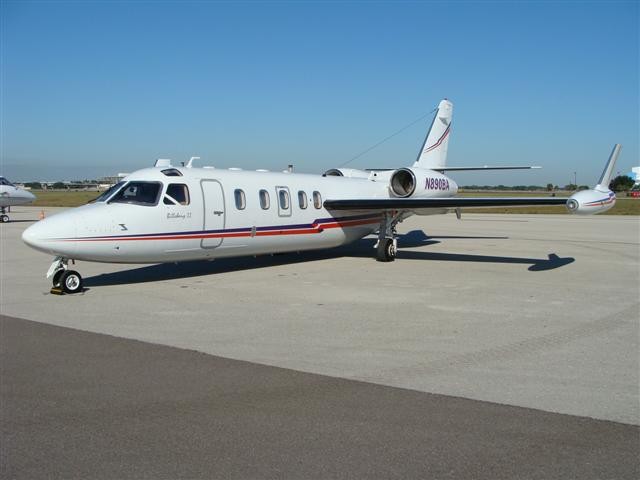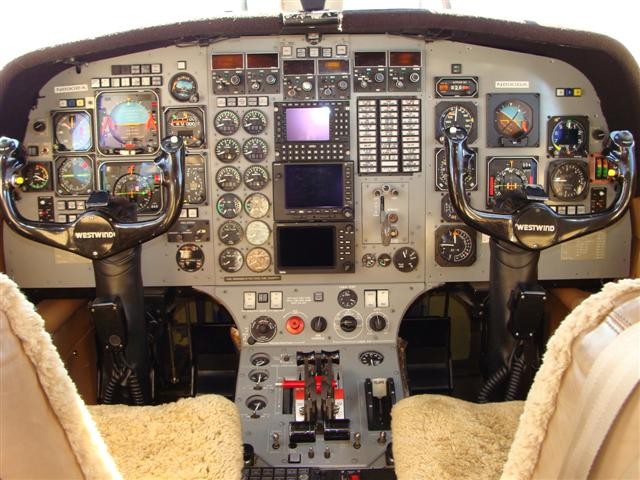


Aircraft Description
Background/History
The lineage of the Westwind can be traced back to 1948 with the first flight of the piston-engined Aero Commander light twin aircraft. The development of the successful Aero Commander line progressed through the 500 and 600 series piston twins, the pressurized 720 and 680PF models and the stretched 680FL, which formed the basis of the turboprop line of 680T, 681 and 690 Turbo Commanders. The 1121 Jet Commander, powered by a pair of General Electric CJ610 turbojet engines, first flew in January 1963, with deliveries of production aircraft beginning in 1965. Manufacturing rights to the line changed hands, begining with the purchase by North American Rockwell in 1967. The 1121 design was sold in 1968 to Israel Aircraft Industries, who produced the aircraft under the name Commodore Jet. The fuselage was stretched to produce the ten-passenger 1123 Westwind in 1972. In 1976, the 1124 Westwind I resulted when the GE turbojets were replaced with Garrett TFE731 turbofan engines. In 1980, the Westwind II was introduced with a redesigned wing, winglets on the tip tanks, increased operating weights and improved hot and high performance. A total of 90 Westwind II aircraft were built between 1980 and 1986 when production ceased.
Power
The Westwind II is powered by a pair of Honeywell TFE731-3-1G turbofan engines rated at 3,700lbs. of thrust each. Inspection interval on the Honeywell engines is 4,200 hours..
Avionics
The panel of the Challenger 601-3R is designed around the Honeywell SPZ-8000 integrated digital avionics package, with left- and right-side primary flight displays and a center multifunction screen, dual Collins VHF 22B, dual VIR 32, dual ADF 462, dual DME 42, triple Laseref INS, dual FMS 800, and Honeywell WU 870 color weather radar.
Design Features
The Westwind II is a medium-range, twin turbofan-powered business aircraft configured as a cantilever mid-wing monoplane with a conventional empennage. The stabilizer surfaces are swept, while the wings follow a straight, tapered planform. The fuselage is low-slung reminiscent of the Aero Commander from which it is derived, and rides low on its retractible tricycle landing gear. There are dual wheels on the nose gear and single wheels on the main gear units. The Westwind II has a redesigned wing and has Whitcomb winglets atop the wingtip fuel tanks. An increased maximum takeoff weight and improved hot and high performance are the primary results of the design changes incorporated into the Westwind II from its predecessor, the Westwind I.
Accomodations
The Westwind II is ordinarily configured to seat seven passengers in an arrangement consisting of a four-seat club and a three-seat, side-facing divan located on the forward starboard side of the cabin. A galley/refreshment center is positioned along the port sidewall across from the divan. A full-width lavatory is located in the aft cabin. Cabin dimensions are 4.8ft. in height, 4.9ft. in width and 15.9ft. in length.
| General | Westwind II, IA-1124A 2 | |||
|---|---|---|---|---|
| Category | Jet < 20,000 lbs. | |||
| Years Aircraft Manufactured | 1980 – 1987 | |||
| Serial Number Range | 295 – 442 | |||
| Retail High Price | $1,300,000.00 / 1,020,110.00€ | |||
| Retail Low Price | $1,200,000.00 / 941,640.00€ | |||
| Characteristics | Westwind II, IA-1124A 2 | |||
| Seating | 2 + 7/10 | |||
| Wing Loading | 76.2 | |||
| Power Loading | 3.2 | |||
| Noise(EPNdB): Takeoff/Sideline/Approach | 84.5/92.8 | |||
| External Dimensions (ft) | Westwind II, IA-1124A 2 | |||
| External Length | 52.3 | |||
| External Height | 15.8 | |||
| External Span | 44.8 | |||
| Internal Dimensions (ft) | Westwind II, IA-1124A 2 | |||
| Internal Length (Overall/Net Height) | 15.9 | |||
| Internal Height | 4.9 | |||
| Internal Width (Max/Floor) | 4.8 | |||
| Baggage | Westwind II, IA-1124A 2 | |||
| External: Cu.Ft./Lb. | N/A | |||
| External: Cu.Ft./Lb. | N/A | |||
| Power | Westwind II, IA-1124A 2 | |||
| Engines | 2 Hon TFE731-3-1G | |||
| Output (lbs ea.)/Flat Rating | 3,700 | |||
| Inspection Interval | 4,200c | |||
| Data based on latest manufactured year | ||||



